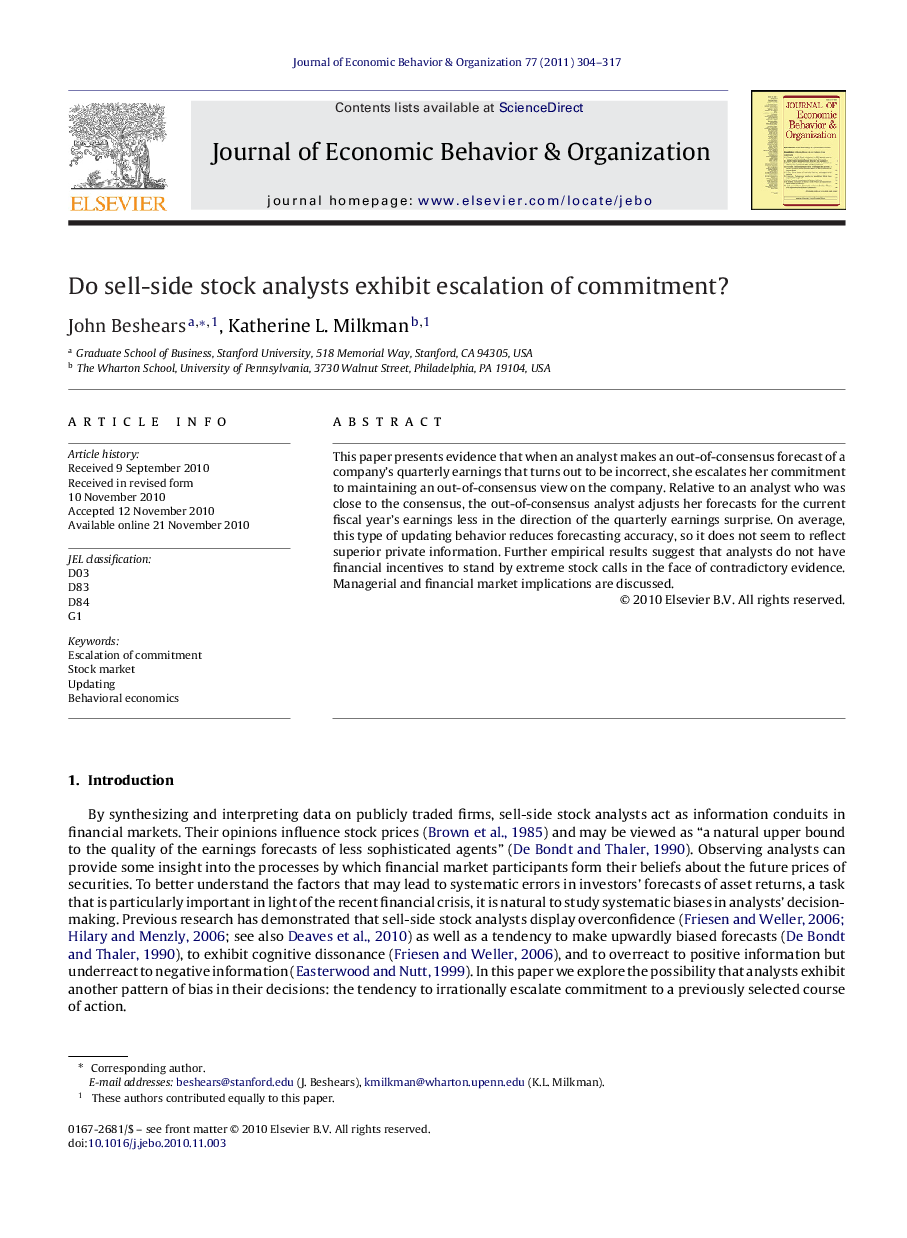انگیختگی ادراکی ایجاد حافظه های جدید اپیزودیک را بهبود می بخشد
| کد مقاله | سال انتشار | تعداد صفحات مقاله انگلیسی |
|---|---|---|
| 36615 | 2011 | 14 صفحه PDF |

Publisher : Elsevier - Science Direct (الزویر - ساینس دایرکت)
Journal : Journal of Economic Behavior & Organization, Volume 77, Issue 3, March 2011, Pages 304–317
چکیده انگلیسی
This paper presents evidence that when an analyst makes an out-of-consensus forecast of a company's quarterly earnings that turns out to be incorrect, she escalates her commitment to maintaining an out-of-consensus view on the company. Relative to an analyst who was close to the consensus, the out-of-consensus analyst adjusts her forecasts for the current fiscal year's earnings less in the direction of the quarterly earnings surprise. On average, this type of updating behavior reduces forecasting accuracy, so it does not seem to reflect superior private information. Further empirical results suggest that analysts do not have financial incentives to stand by extreme stock calls in the face of contradictory evidence. Managerial and financial market implications are discussed.
مقدمه انگلیسی
By synthesizing and interpreting data on publicly traded firms, sell-side stock analysts act as information conduits in financial markets. Their opinions influence stock prices (Brown et al., 1985) and may be viewed as “a natural upper bound to the quality of the earnings forecasts of less sophisticated agents” (De Bondt and Thaler, 1990). Observing analysts can provide some insight into the processes by which financial market participants form their beliefs about the future prices of securities. To better understand the factors that may lead to systematic errors in investors’ forecasts of asset returns, a task that is particularly important in light of the recent financial crisis, it is natural to study systematic biases in analysts’ decision-making. Previous research has demonstrated that sell-side stock analysts display overconfidence (Friesen and Weller, 2006 and Hilary and Menzly, 2006; see also Deaves et al., 2010) as well as a tendency to make upwardly biased forecasts (De Bondt and Thaler, 1990), to exhibit cognitive dissonance (Friesen and Weller, 2006), and to overreact to positive information but underreact to negative information (Easterwood and Nutt, 1999). In this paper we explore the possibility that analysts exhibit another pattern of bias in their decisions: the tendency to irrationally escalate commitment to a previously selected course of action. The psychology literature on “escalation bias” suggests that people often become irrationally overcommitted to a previously selected course of action when they feel the need to justify past decisions that have had bad outcomes (Staw, 1976) or when they feel that they have already made large investments in past decisions (Arkes and Blumer, 1985). Such escalation can have important managerial implications. For example, a manager who escalates commitment to hand-picked investment projects or employees who continually underperform may be misallocating resources. An awareness of this bias might offset such errors. We study the possibility that stock analysts exhibit escalation bias. We argue that if an analyst's views on a firm differ dramatically from those of her peers, she may feel pressure to invest more time and energy than usual supporting her opinion. Once an analyst has invested in such an opinion, escalation bias may make her particularly reluctant to back down from that position, even in the presence of contradictory information. This paper presents evidence that analysts can indeed become committed to their out-of-consensus views in a way that decreases their responsiveness to firms’ financial disclosures. We document this pattern of stubbornness among extreme forecasters using Institutional Brokers’ Estimate System (I/B/E/S) data from January 1990 to March 2008. We find that when a company announces a quarterly earnings surprise relative to the consensus (median) forecast, analysts whose forecasts differed meaningfully from consensus in the wrong direction update their forecasts for subsequent quarters less in the direction of the earnings surprise than analysts whose forecasts were closer to consensus, controlling for analyst–firm fixed effects. To illustrate this finding with an example, consider two analysts, A and B, covering company XYZ. Imagine that analyst A has estimated that this company will achieve earnings per share (EPS) of $1.10 for the first quarter of its fiscal year and $4.40 for the entire year, while analyst B has estimated that the same company will achieve EPS of $1.00 for fiscal quarter one and $4.00 for the entire year. Analysts other than A and B cover company XYZ, and the median EPS estimate for the company's first fiscal quarter is $1.00. Now imagine that XYZ's earnings announcement for the quarter reveals that its actual first quarter EPS was $0.90, proving that the estimate of analyst A was off in the wrong direction relative to consensus. On average, we find that the extreme analyst (analyst A) adjusts her EPS estimate for the remaining quarters less in the direction of the earnings surprise than the analyst with a forecast matching the consensus (analyst B). For instance, analyst A might update her EPS estimate for the fiscal year to $4.19 from $4.40, a change of just $0.01 to her forecast for the remaining quarters in the direction of the earnings surprise after accounting for the mechanical incorporation of her $0.20 miss of Q1 EPS, while analyst B might update her EPS estimate for the fiscal year to $3.84 from $4.00, a change of $0.06 to her forecast for the remaining quarters in the direction of the surprise after accounting for the mechanical incorporation of her $0.10 miss of Q1 EPS. See Fig. 1 for a pictorial representation of this example

